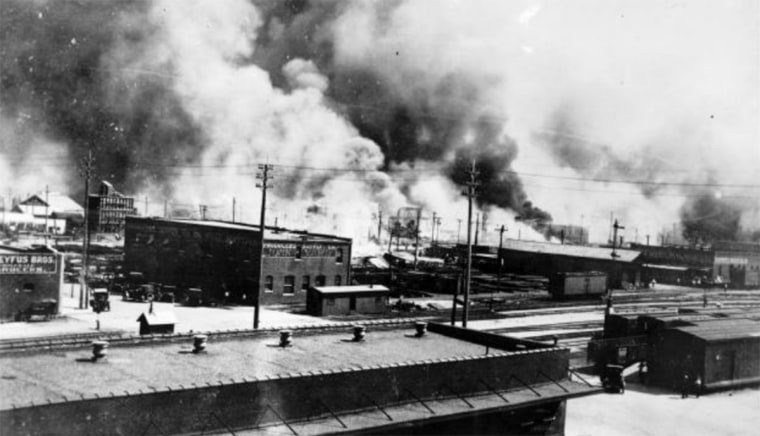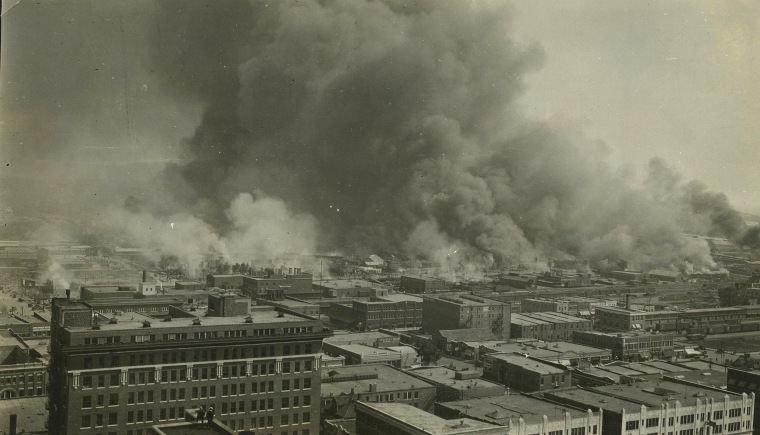A possible mass grave site from the 1921 Tulsa Race Massacre has been found, according to researchers.
Search for victims of the worst racially motivated massacre in the history of the United States believed to have been buried in mass graves began last October.
Coming nearly 100 years after the massacre, authorities in Oklahoma say the search would afford residents of Tulsa and the survivors an insight into a crime scene that was never fully investigated.
Experts at the University of Oklahoma, who uncovered the possible mass grave site, are unsure how many bodies are underneath, NBC News reported.
A senior researcher for the Oklahoma Archaeological Survey, Scott Hammerstedt on Monday said geophysical scanning identified two spots at the Oaklawn Cemetry that might be holding bodies of those killed in the deadly race massacre.

“I’m as confident as I can be in the results that this is a very big candidate with something associated with the massacre,” Hammerstedt said.
According to NBC News, surveys confirmed suspicions that one area might be a grave, as well as, a newly found trench under the soil of about 30 by 25 feet.
The massacre, christened as the Tulsa riot, took place from May 31 to June 1, 1921. A white mob invaded and attacked residents of black residents living in Greenwood.
Greenwood, at that time, was the most thriving African-American neighborhood in the United States. Nicknamed the ‘Black Wall Street, Greenwood was home to highly successful and profitable black-owned businesses.
The mob charred businesses, homes, and churches and after the smoke cleared, more than 35 blocks were destroyed. It is believed that at least 100-300 people, mostly blacks, were killed while a thousand more were left homeless in the two days of fighting.
A forensic anthropologist at the University of Florida, Phoebe Stubblefield has warned that the number of bodies buried in the graves could be anywhere from 10 to 100.
“We just don’t know what level of preservation we’ll get,” Stubblefield said.
“We’ve had an intense study for over a year, just looking at death figures,” Historian Scott Ellsworth, an aide to the Oklahoma Commission set to study the 1921 riot, said at the time of beginning the search.
He added, “I think we are now convinced this is the largest single incident of racial violence in American history.”
The Commission spoke to over 60 living black survivors during its work and investigated reports of airplanes bombing blacks and of bodies being tossed into the Arkansas River.

Tulsa’s Mayor G.T. Bynum said: “We can’t change the past, but we can control what we do today. In 2019, we will do right by our neighbors. The scanning that starts today is the result of decades of research by historians to narrow the search to a handful of primary locations.
“But this process has shown us that many families passed down stories about the 1921 Tulsa Race Massacre and possible grave locations that were never properly recorded.”
For him, the “only way to move forward in our work to bring about reconciliation in Tulsa is by seeking the truth honestly.”
“As we open this investigation 98 years later, there are both unknowns and truths to uncover,” he said in a statement last year.
According to Bynum, the need to get an insight into the scenes of the heinous massacre “is a matter of basic human decency.”
Bynum, before winning the mayoral seat in 2016, said he had interviewed people who had investigated the possibility of mass graves in 2012.
They found that there were two cemeteries and a city park where victims from the massacre might have been dumped.
The search would look at New block Park, Booker T. Washington Cemetery and Oaklawn Cemetery—it is believed that they are the greatest potential for mass graves within the Tulsa city limits.










